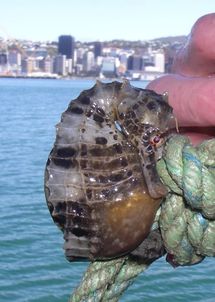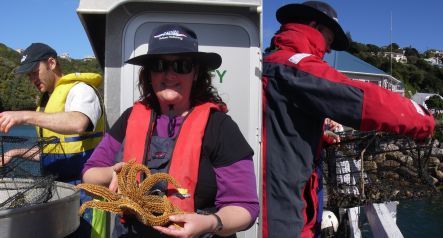
A hermit crab and a couple of decorator crabs (left) and a piecrust crab (right) - all native crab species that were trapped and released in Oriental Bay (images: A. Ballance)
The Ministry for Primary Industries (MPI) manages New Zealand’s biosecurity systems, trying to prevent unwanted pest and diseases arriving in the country and becoming established. As well as biosecurity checks at familiar places such as airports, MPI contracts NIWA to carry out regular checks in the marine environment, targeting high risk areas in harbours that are international ports. These surveys are carried out twice a year around the country, and involve diving, trapping and using a benthic sled to collect samples from the seafloor.
 Alison Ballance joins NIWA marine biologists Kate Neill and Warrick Lyon on board NIWA vessel Ikatere in Wellington Harbour to see how the work is done. As well, Brendan Gould, manager of MPI’s Surveillance and Incursion Investigation Group explains why it is important to monitor high-risk harbours such as international ports for new marine pests, and NIWA principal scientist Graeme Inglis talks about the science behind the survey protocol for the marine biosurveillance programme.
Alison Ballance joins NIWA marine biologists Kate Neill and Warrick Lyon on board NIWA vessel Ikatere in Wellington Harbour to see how the work is done. As well, Brendan Gould, manager of MPI’s Surveillance and Incursion Investigation Group explains why it is important to monitor high-risk harbours such as international ports for new marine pests, and NIWA principal scientist Graeme Inglis talks about the science behind the survey protocol for the marine biosurveillance programme.
Native species caught in traps, such as the pregnant male seahorse (left) and the eleven-armed starfish (below) are counted and then returned to the sea.
The marine biosurveillance surveys focus on looking for the following six species:
Chinese mitten crab, Eriocheir sinensis
Mediterranean fanworm, Sabella spallanzanii
Northern Pacific seastar, Asterias amurensis
European shore crab, Carcinus maenas
Asian clam, Potamocorbula amurensis
Caulerpa taxifolia (a marine aquarium weed)
More information can found here.
If you suspect you have found an unwanted pest or disease please call MPI on 0800 80 99 66.

Kate Neill holds an eleven-armed starfish, while Warrick Lyon (right) holds a box trap containing lots of Cominella whelks (images: A. Ballance)

